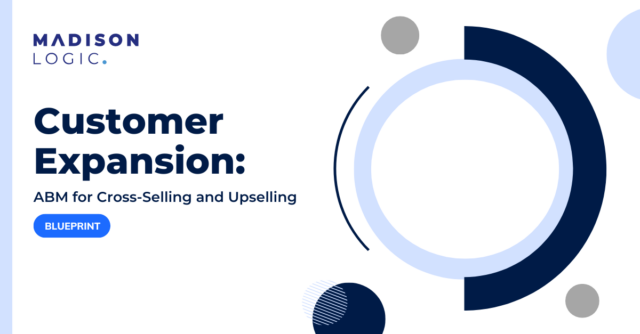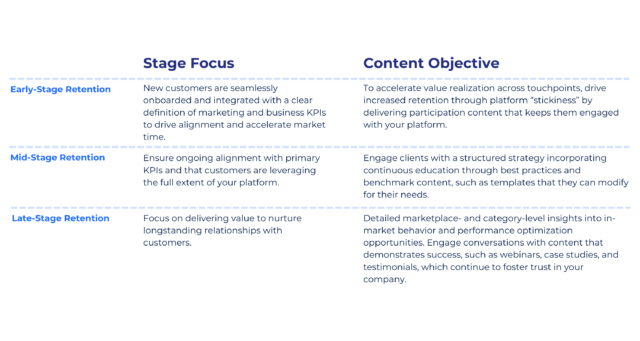
Marketing and sales teams can default into thinking once the deal is signed, the hard work is done. But the reality is, the real return on investment (ROI) begins at the dotted line.
Acquiring new customers is not only five times more expensive than retaining existing customers, but there’s only a 5-20% chance of closing a sale. Yet existing customers, according to Paul W. Farris’ Marketing Metrics, are 3-10 times more likely to close than new customers.
Companies provide the infrastructure for customers to do what they want, when they want, how they want. Customers constantly choose to interact with their products and services, and want to find the best mix of services to ensure they can accomplish their day-to-day responsibilities and goals. Customers also prefer the ease of adding a new product or upgrade from an existing vendor versus having to go through the qualification steps and “red tape” to bring on a new vendor. It’s up to companies to ensure that their customers continuously see the value in their offerings and trust in the brand to provide exactly what they need when they need it—with the functionality for however they’re going to use it.
Evaluating customer engagement and health helps to alert customer success and sales that there’s potential interest for cross-selling or upselling. Yet understanding how to strike at these opportune moments requires cross-collaborative initiatives beyond simple discussions around customer interest.
You need a strong retention strategy, filled with insights from each department and feedback from customers, so that your customer marketing and demand marketing teams can deliver sales enablement materials across various marketing channels that reinforce why your company should remain their partner of choice—and how your offering will enable them to continue to accomplish their goals.
Here’s a deeper look into why your account-based marketing (ABM) engagement efforts don’t end after the sale.
Deliver a Unified, Full-Funnel Experience
In most organizations, a client relationship sits with marketing only until it’s about to close. At that point, when it becomes a marketing qualified lead (MQL), responsibility for the relationship shifts to sales (usually) for all eternity. It’s important for marketers to take a bigger role in maintaining that customer relationship, and to work with their sales team instead of relying on them solely to nurture those relationships. By leveraging an ABM strategy and aligning sales, marketing, and customer success teams, you develop deeper insights that lead to delivering a unified, full-funnel experience.
In a traditional B2B marketing funnel, marketing and sales conduct their campaigns and outreach efforts. The salesperson is the first team prospects speak to, with conversations serving to fortify the brand and relationship. And once the prospect converts, the salesperson and marketing team share their insights so that a customer success representative can quickly understand the account’s interests so they can help grow the customer’s trust and propel the relationship into the retention phase.
Within an ABM marketing and sales framework, client health is continually assessed by looking across the entire account—and not just gaining feedback from the direct points of contact that meet with the customer success team. The marketing team continues to monitor account data, such as intent data and customer research behavior, to track customer health and anticipate what customers may need to maintain a healthy relationship with the product. Managed well, this is a data-sharing cycle of never-ending returns.
Product engagement data is another significant factor that customer success and marketing can equally monitor, as it shows product usage and behavior. Marketing uses this data to optimize user guides to ensure a steady onboarding experience and product adoption. The data also points to any roadblocks in functionality or onboarding, which is valuable feedback for marketing and the product team to ensure they develop content that sets customers up for success.
Data Is an Important Driver for Expansion Campaigns
For expansion campaigns, your marketing motions already fall under an ABM strategy: your focus is on your current accounts. Data provides deeper insight into creating content, then matching content with marketing channels to surround buyer groups that are interested in cross-sell or upsell opportunities.
ABM engagement efforts rely on a continuous flow of data. It makes sense to track your base’s activity, as well as your prospects’. Discovering customer account changes across the entire account is vital to continue engagement efforts: Have team members left, or have new ones been added? What is the committee focused on today? You can use surge data to determine which purchases the committee is currently researching alongside intent data to anticipate content that serves their interests. You can craft webinars that speak to customers’ interests and create content that you will serve to customers through the appropriate marketing channels.
All of your touchpoints, whether from customer success, marketing, or sales, need to focus on what the account needs—versus what the company thinks they need—to advance an expansion campaign. Monitoring account activity on an ongoing basis gives marketers the opportunity to provide relevant content to meet customer needs. This “always-on customer service” means that because marketers are always aware of what clients are researching, they have the ability provide meaningful content in a timely and ongoing fashion.
You need to select content and messaging that supports your team and speaks to the buying group to demonstrate that you’re the right partner to help them with their efficiency toward achieving their goals or helping them discover a pain point that they had no idea even exists. Intent data, technographic data, and firmographic data help you anticipate their interests, as well as add to the narrative derived from the sales and customer success teams’ conversations with customers and additional buying groups throughout the account. When you deeply observe your buying group’s actions across your website and engagement with advertisements, you can create distinct cross-sell and upsell campaigns that drum up product demand and value realization at the right stage at the right time.
You Want to Provide Incredible Customer Experiences
When target accounts that perfectly match your ideal customer profile convert, you obviously want to deliver exceptional customer service. ABM engagement efforts allow you to monitor accounts to help ensure a positive relationship—even when the account isn’t talking to a company representative.
Your customer roster and retention rate are large indicators of customer satisfaction. A high retention rate strengthens your brand reputation and drives customer loyalty. When customer feedback is increasingly implemented into the product roadmap, customers respond positively—and the same can be said when marketing implements an account’s interests into their marketing motions. With an ABM strategy, marketing proactively gathers information and feedback from data to anticipate what content keeps customers engaged. Marketing can then create assets, such as articles and webinars, that truly speak to customers’ interests. Case studies are another valuable tool to boost customer loyalty, as buyers will listen to partner companies they trust or similar companies within their industry that have seen success with your product.
ABM engagement is at its best when it ensures more personalization throughout the customer journey. Personalization, in terms of a customer journey, shows that the company continues to pay attention to the account, what it needs, and how the relationship can continue to grow.
As you serve content to customers and buying groups through your various marketing channels, you want to ensure that it matches the persona as well as where they are within their customer journey.

An account that’s just onboarding is too early to be sold to, and it’s too early to use their success to sell to someone else. Early accounts will, however, be open to content that sets them up for successful onboarding. And yet, regardless of stage, you can deliver content that drives engagement through sophisticated educational materials, whether it’s product user guides, articles detailing benchmarks for success, or white papers containing in-market insights. You want to continuously serve content that establishes trust and product quality—and your ABM insights help ensure customers get what they need to succeed.
You Develop Deeper Insight into Marketing’s Impact on Return on Investment
When companies improve cross-functional support, they experience better, more precise resource allocation, which allows for every team to expand into deeper insights and efficiency within their department motions.
Tracking expansion and retention metrics helps you understand how your customer expansion campaigns impact overall company health. You’ll also gain insights into customer health and signals to anticipate any cross-sell or upsell opportunities. Strong retention and expansion metrics signal that your brand-and-demand strategy is working, especially if the customer account recommends you to other subsidiaries in their company or refer other companies to you.
The closer you are to real-time information around your metrics, the more proactive you can be with optimization efforts. Retention metrics like customer lifetime value (CLV) and annual contract value help you scope out retention and acquisition efforts to determine a timeline for positive ROI across accounts. Net revenue retention (NRR) is a particularly important revenue growth metric, as you can look deeply into cross-sell and upsell initiatives to understand where you’ve gained and lost value with your customers. Customer satisfaction, measured as a net promoter score (NPS) through customer feedback surveys with questions that can only be answered on a 0-10 scale, measures how loyal customers are to your company, which will be indicative of your expansion campaigns’ successes. Also track and evaluate the timeline for all cross-sell and upsell opportunities created, won, and loss, as it will help you predict when these opportunities may come up across similar customer accounts.
Having a clear understanding of these metrics allows you to proactively adjust your marketing strategy and budget across the entire sales funnel and discover which accounts serve as your most valuable, especially in terms of growth potential. When you import these metrics into your marketing automation platform (MAP) and customer relationship management (CRM), you can proactively determine what relevant content may drive urgency throughout the funnel, which continues to positively impact your metrics and regain your customer acquisition costs faster throughout future ABM campaigns.
Matching metrics to your ABM key performance indicators (KPIs) also strengthens your ability to build a narrative around your marketing campaigns’ successes, including identifying key accounts that can serve as case studies, testimonials, and brand partners. These high-value accounts further influence your marketing approach as you discover new opportunities to expand your reach, grow your target audience, and create deeper insights and richer storytelling through your metrics. By continuously keeping your accounts at the center of your marketing strategy, you set yourself up for ABM success.
Madison Logic Paves the Way for Smarter ABM Engagement with Customers
Customer health and buyer intent data is too important to your company’s bottom line. McKinsey studied 40 public B2B companies in the SaaS industry and determined that companies with a net retention score of 120% had higher growth rates compared to other companies. But if you can’t recognize the signals for expansion campaigns—hence, opting out on further ABM engagement efforts—you’ll miss out on the ample opportunities to help your customers with their growth goals while also positively impacting your company’s revenue stream.
Madison Logic is an ABM platform that bridges your data from multiple source systems into a single platform to empower marketers to make better data-driven decisions. By gathering proprietary engagement data, technographic data, and B2B buyer research into a comprehensive data set, you gain access to a best-in-class lead scoring system that predicts when accounts are ready to buy and have the highest opportunity to convert. And when you integrate your channel sources with the ML Platform, ML Measurement can then track cross-channel performance, account engagement, and pipeline and revenue impact, so that you can quickly measure the metrics that matter to your business and focus on deeper insights that drive faster campaign optimization and smarter cross-department collaboration.
Ready to ensure your ABM engagement efforts don’t end after the sale? Our Customer Expansion: ABM for Cross-Selling and Upselling Blueprint guides you through the five vital steps you need to take for successful ABM expansion campaigns that truly serve your customers. Request a demo today to also learn more about how Madison Logic’s holistic view and data-driven insights can help you earn more engagement across the funnel.



